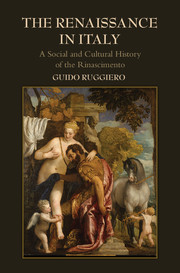Book contents
- Frontmatter
- Dedication
- Contents
- List of Illustrations
- Acknowledgments
- Maps
- Introduction: The End of the World and Its Rebirth (Rinascita) as the Rinascimento
- 1 Legitimacy: A Crisis and a Promise (c. 1250–c. 1340)
- 2 Civiltà: Living and Thinking the City (c. 1300–c. 1375)
- 3 Plague: Death, Disaster, and the Rinascita of Civiltà (c. 1325–c. 1425)
- 4 Violence: Social Conflict and the Italian Hundred Years’ War (c. 1350–1454)
- 5 Imagination: The Shared Primary Culture of the Early Rinascimento (c. 1350–c. 1475)
- 6 Courts: Princes, Aristocrats, and Quiet Glory (c. 1425–c. 1500)
- 7 Self: The Individual as a Work of Art (c. 1425–c. 1525)
- 8 Discovery: Finding the Old in the New (c. 1450–c. 1560)
- 9 Re-Dreams: Virtù, Saving the Rinascimento, and the Satyr in the Garden (c. 1500–c. 1560)
- 10 Reform: Spiritual Enthusiasms, Discipline, and a Church Militant (c. 1500–c. 1575)
- 11 Retreat: The Great Social Divide and the End of the Rinascimento (c. 1525–c. 1575)
- Epilogue: The Diaspora of the Rinascimento
- Bibliography: A Short List of Works Used
- Index
11 - Retreat: The Great Social Divide and the End of the Rinascimento (c. 1525–c. 1575)
Published online by Cambridge University Press: 05 December 2014
- Frontmatter
- Dedication
- Contents
- List of Illustrations
- Acknowledgments
- Maps
- Introduction: The End of the World and Its Rebirth (Rinascita) as the Rinascimento
- 1 Legitimacy: A Crisis and a Promise (c. 1250–c. 1340)
- 2 Civiltà: Living and Thinking the City (c. 1300–c. 1375)
- 3 Plague: Death, Disaster, and the Rinascita of Civiltà (c. 1325–c. 1425)
- 4 Violence: Social Conflict and the Italian Hundred Years’ War (c. 1350–1454)
- 5 Imagination: The Shared Primary Culture of the Early Rinascimento (c. 1350–c. 1475)
- 6 Courts: Princes, Aristocrats, and Quiet Glory (c. 1425–c. 1500)
- 7 Self: The Individual as a Work of Art (c. 1425–c. 1525)
- 8 Discovery: Finding the Old in the New (c. 1450–c. 1560)
- 9 Re-Dreams: Virtù, Saving the Rinascimento, and the Satyr in the Garden (c. 1500–c. 1560)
- 10 Reform: Spiritual Enthusiasms, Discipline, and a Church Militant (c. 1500–c. 1575)
- 11 Retreat: The Great Social Divide and the End of the Rinascimento (c. 1525–c. 1575)
- Epilogue: The Diaspora of the Rinascimento
- Bibliography: A Short List of Works Used
- Index
Summary
From Spiritual to Political Reform: Prophets of Reestablished Italian Glory
Reformers and reform sentiment were abroad in the sixteenth century and pressing for change well beyond the religious arena. In fact, many of the same people who were concerned with the spiritual reform of the Church were also profoundly concerned with reforming the political world of the Italian city-states in order to revitalize the traditional political order of the peninsula in the face of invasions and a deplored loss of political autonomy. As we have seen, these were crucial issues for the important political thinkers and social critics of the first decades of the century, like Machiavelli and Castiglione, and were deeply embedded in the apparently less political writings of writers like Ariosto, Aretino, Bembo, Gambara, and Colonna. They remained crucial even in the years of the Council of Trent and after, in fact, for the rest of the premodern period.
Gasparo Contarini (1483–1542), whom we have already met as a religious reformer, provides a good example of the way in which church reforming ideology and state reform often intermixed in fertile ways. Although he rejected for himself the spiritual withdrawal from the world of his fellow Venetians Vicenzo Querini and Tommaso Giustiniani, he remained committed to religious reform even as he became a major figure in the crucial political events of the day. Thus he played an important role in Venetian politics, serving as a diplomat representing Venice in the negotiations forming the League of Cognac, and after the Sack of Rome helping to reestablish peace between the emperor and Clement VII. At the same time, however, he gained a reputation for his Christian reforming ideals and was appointed a cardinal in 1535 at the age of fifty-two.
- Type
- Chapter
- Information
- The Renaissance in ItalyA Social and Cultural History of the Rinascimento, pp. 531 - 574Publisher: Cambridge University PressPrint publication year: 2014



